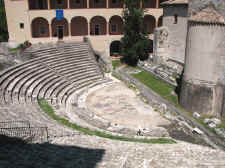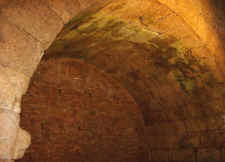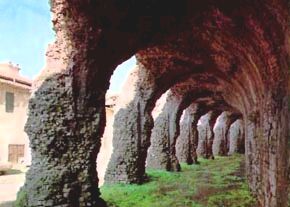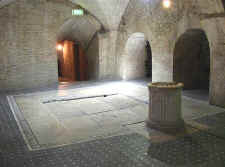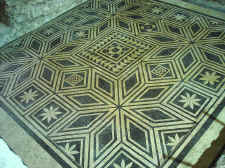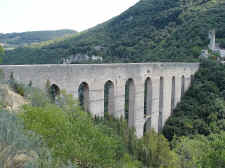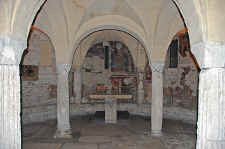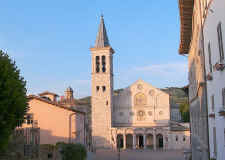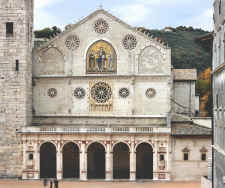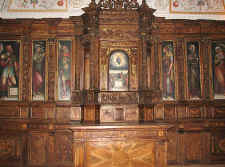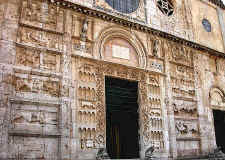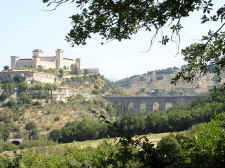Roman architecture in Spoleto● The Roman theatre is a reconstruction of the original for the most part. The scene is occupied by the former church of St. Agatha, currently housing the National Archaeological Museum. Various summer events are held here. Roman theatre ● Ponte Sanguinario ("bloody bridge"), a Roman bridge 1st century BC. The name is traditionally attributed to the persecutions of Christians in the nearby amphitheatre. The bridge is now below ground level but is in an excellent state of preservation and easy to visit. Ponte Sanguinario ● Roman amphitheatre (2 C AD) was converted into a fortress by Totila in 545 and in Middle Ages was occupied by shops, while the Church of San Gregorio Minore was built in the cavea. The stones were later used to build the Rocca. Now only partially visible inside the former Minervio barracks, this is a striking building with two orders of arches. Long sections of the lower ambulacrum, together with a part of the upper ambulacrum, can still be seen.
Roman amphitheatre ● Casa Romana (Roman House) Next to the Palazzo Comunale, just above the level of the Roman Forum, there are the remains of a Roman house from the 1st century AD, restored in the 2 C AD and in use until the Early Middle Ages. Excavations in 1885 and in 1912-13 revealed the rooms around the peristyle. A dedication to the Emperor Caligula suggested that the building belonged to Vespasia Polla, mother of the Emperor Vespasian. She was born in Nursia and held possessions in Vespasiae, a locality between Nursia and Spoletium. The atrium is paved with mosaics of geometric shapes composed of white, red and black tesserae, and there are traces of Roman fresco on some of the walls. ● Ponte delle Torri, the most famous structure at Spoleto, is a striking 13 C aqueduct, possibly built on Roman foundations. It now carries a footpath which is open to the public. Ponte delle Torri ● The Church of Sant'Ansano was constructed in the 18 C over a series of former buildings including a Roman temple (1st century AD) and the Mediaeval Crypt of St. Isaac. The church has a 16 C cloister. Crypt of St. Isaac ● The Basilica of San Salvatore (4 -5 C) incorporates the cella of a Roman temple and is one of the most important examples of Early Christian architecture anywhere.
Churches and Convents of Spoleto● The Duomo (Cathedral) of S. Maria Assunta, begun around 1175 and completed in 1227. The Romanesque edifice contains the tomb of Filippo Lippi, who died in Spoleto in 1469, designed by his son Filippino Lippi. The church also houses a manuscript letter by Saint Francis of Assisi. The severe lines of the Romanesque style are made brilliant by the numerous rose windows and luminous mosaics (early 1200's), while the terraced portico creates the effect of intermittent support. Inside there are three naves and the floor is still the original one. You can also see a bronze bust of Pope Urban VIII by Bernini, there are some lovely frescoes in the bishop Eroli's chapel by Pinturicchio, as well as a commemorative monument by San Filippo Lippi and some other noteworthy frescoes. ● San Pietro extra Moenia (fuori le mura) was built over an ancient necropolis in 419 to house St. Peter's relics. It was rebuilt starting in the 12 C, although the work dragged on until the 15 C when a remarkable Romanesque façade was added. This has three doors with rose-windows, with a splendid relief decoration by local artists. It rivals S. Rufino in Assisi, which it resembles, as the finest extant specimen of Umbrian Romanesque. Facade of San Pietro extra Moenia
● San Ponziano is a notable complex lying outside the city's walls, dedicated to the patron saint of Spoleto. The church was built in the
12 C in Romanesque style, but was later modified by Giuseppe Valadier. The crypt, however, has remained untouched, with its five small naves and small apses with cross-vault, ancient Roman spolia columns and frescoes of the
14 -15 C.
Palazzi, museums, castles of Spoleto
● The Palazzo Comunale (13 C) restored after the
earthquake of Rocca Albornoziana and the Ponte delle Torri
● The Palazzo Racani-Anoni (16 C) has a worn graffito decoration attributed to Giulio Romano. The inner courtyard has a notable fountain.
|
